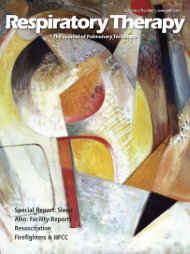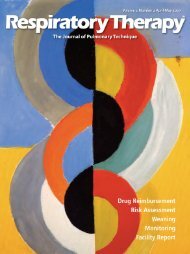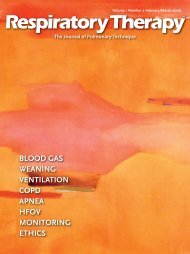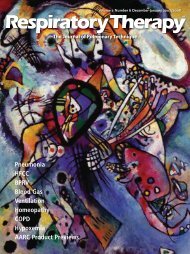RT 02-03 JJ07 main web - Respiratory Therapy Website
RT 02-03 JJ07 main web - Respiratory Therapy Website
RT 02-03 JJ07 main web - Respiratory Therapy Website
You also want an ePaper? Increase the reach of your titles
YUMPU automatically turns print PDFs into web optimized ePapers that Google loves.
Table 1 Reported features that may suggest a sleep<br />
related breathing disorder<br />
Features during sleep Snoring<br />
Witnessed apnoeas<br />
Cyanosis<br />
Parental concern about their child’s breathing<br />
Restless sleep<br />
Unusual sleeping posture<br />
Symptoms on waking Difficult to rouse in the morning<br />
Irritability/bursts of anger on waking<br />
Morning headaches or vomiting<br />
Lack of appetite for breakfast<br />
Daytime features Mouth breathing<br />
Excessive daytime sleepiness<br />
Hyperactivity/behavioural disturbance<br />
Learning/memory difficulties<br />
Developmental delay<br />
Poor growth<br />
pulmonary or chest wall disease should be performed. The<br />
contribution of neuromuscular diseases to sleep disordered<br />
breathing should be considered in children with disorders<br />
affecting muscle strength and tone, including cerebral palsy,<br />
congenital and acquired myopathies and muscular dystrophies,<br />
particularly in association with kyphoscoliosis, and disorders<br />
affecting control of upper airway tone and reflexes, such as<br />
bulbar or pseudobulbar palsy.<br />
Potential complications of sleep disordered breathing include<br />
failure of expected growth. 13 Cardiac examination is usually<br />
normal, although signs of pulmonary hypertension may be<br />
present. Systemic hypertension is probably less common in<br />
children than in adults with obstructive sleep apnea but has<br />
been described. 14,15 Cor pulmonale was described in earlier<br />
studies but is uncommonly seen, possibly due to earlier<br />
recognition and intervention of severe obstructive sleep apnea.<br />
Although clearly important, clinical history and examination<br />
alone are unable to differentiate between children with and<br />
without significant sleep related breathing disorders. Symptoms<br />
are common; the prevalence of habitual snoring in a general<br />
population of children is 10%. 16 However, most habitual snorers<br />
will have primary snoring, characterised by the absence of<br />
associated hypoxaemia, hypercapnia, sleep disruption, or<br />
daytime symptoms. This is a benign condition that does not<br />
require treatment. Only a small proportion of children who<br />
habitually snore have obstructive sleep apnea requiring<br />
treatment. Therefore, attempts have been made to devise<br />
screening methods to identify children at risk of significant<br />
sleep related breathing disorders.<br />
Brouillette and others 17 designed a clinical scoring system based<br />
on three questions about breathing during sleep. When applied<br />
to a general pediatric population, this was able to discriminate<br />
between healthy children and those with severe obstructive<br />
sleep apnea syndrome (OSAS) but did not identify those with<br />
mild to moderate OSAS. Carroll and coworkers 18 extended this<br />
scoring system and applied it to a population of children<br />
referred to a sleep clinic for assessment of snoring or difficulty<br />
breathing during sleep. In this setting it was not possible to<br />
reliably distinguish primary snoring from OSAS using the<br />
clinical history alone. Preutthipan and others 19 studied parents’<br />
ability to predict the severity of childhood OSAS based on<br />
observation of their child’s sleep. They showed that parents of<br />
children with severe OSAS were more likely to report cyanosis,<br />
obstructive apneas, and extremely loud snoring. They felt the<br />
need to shake or watch their child more frequently during sleep<br />
and were afraid of their child’s breathing at night. However, no<br />
single parental observation or combination of these could be<br />
used to confidently predict severe OSAS. Other investigators<br />
have also shown that clinical evaluation alone is not sufficient<br />
to identify children with significant sleep related breathing<br />
difficulties. 20,21 A group at high risk for severe obstructive sleep<br />
apnea can be identified but milder degrees may be missed.<br />
Therefore, some form of sleep study is advisable for further<br />
evaluation of symptomatic cases.<br />
What investigations are available?<br />
Overnight polysomnography (PSG) in a sleep laboratory is<br />
considered to be the gold standard investigation for suspected<br />
abnormal breathing during sleep in children. A dedicated<br />
pediatric sleep laboratory, which can accommodate the unique<br />
needs of children, is the ideal setting for such investigations.<br />
Studies in adult laboratories may be suboptimal and will be<br />
misinterpreted if adult diagnostic standards are applied. Despite<br />
the fact that young children take frequent naps, PSG is best<br />
performed at night during natural sleep. Marcus and others 22<br />
reported that nap studies had a positive predictive value of<br />
100%, but a negative predictive value of only 20% for sleep<br />
disordered breathing. Nap studies can be useful for screening<br />
but are of limited diagnostic value, as they may not include<br />
episodes of rapid eye movement (REM) sleep; the behavioural<br />
state during which abnormalities are most likely to be seen.<br />
There is also some evidence that a sleep study is more likely to<br />
be abnormal in the later part of the night, which would be<br />
missed by a nap study. Sedatives should not be used to induce<br />
sleep for PSG as they depress upper airway dilator muscle<br />
function and may induce worse apnea in children predisposed<br />
to OSAS. 23<br />
PSG simultaneously records a number of physiological<br />
variables, which can be selected depending on the clinical<br />
context in which the study is being carried out. They typically<br />
include respiratory movements, gas exchange, cardiac rate and<br />
rhythm, sleep state, and muscle activity. <strong>Respiratory</strong> effort can<br />
be assessed by simultaneously recording chest and abdominal<br />
wall movement using inductance plethysmography. Paradoxical<br />
inward rib cage movement (PIRCM) during inspiration is<br />
associated with upper airway obstruction during sleep. 24<br />
However, the usefulness of this measurement is limited in<br />
infants and young children, in whom paradoxical rib cage<br />
movements occur physiologically during REM sleep. A more<br />
accurate way of measuring respiratory effort utilises<br />
oesophageal pressure monitoring, but this is more invasive and<br />
the presence of an oesophageal manometer can interfere with<br />
sleep, making it unacceptable to many children. Airflow at the<br />
nose and mouth are seldom measured directly but proxy<br />
measures indicating the presence of gas flow, such as<br />
temperature change measured with a thermistor, can detect<br />
apneas. Oxygenation is measured by pulse oximetry, and carbon<br />
dioxide tensions can be measured non-invasively using an endtidal<br />
CO 2 catheter or transcutaneous CO 2 electrode.<br />
Sleep staging ensures that the study includes periods of REM<br />
sleep. It also allows arousals from sleep, including subcortical<br />
arousals, to be identified, and hence provides information on<br />
sleep quality. Staging sleep involves the combined measurement<br />
of the electroencephalogram (EEG), electro-oculogram (EOG)<br />
72 <strong>Respiratory</strong> <strong>Therapy</strong> Vol. 2 No. 3 � June-July 2007











